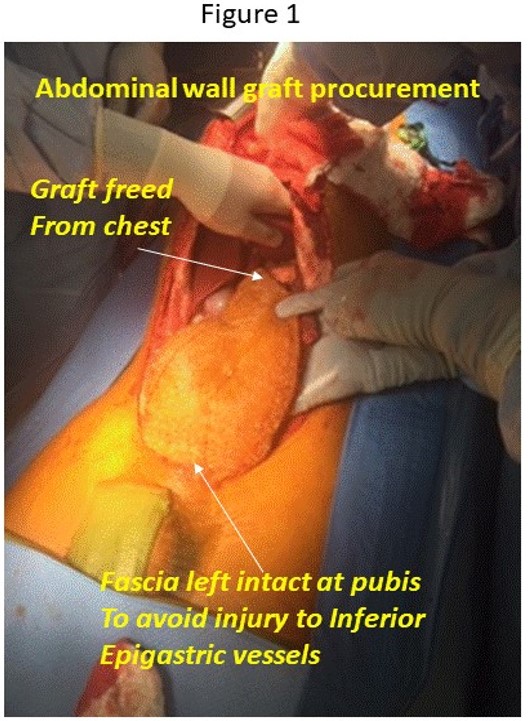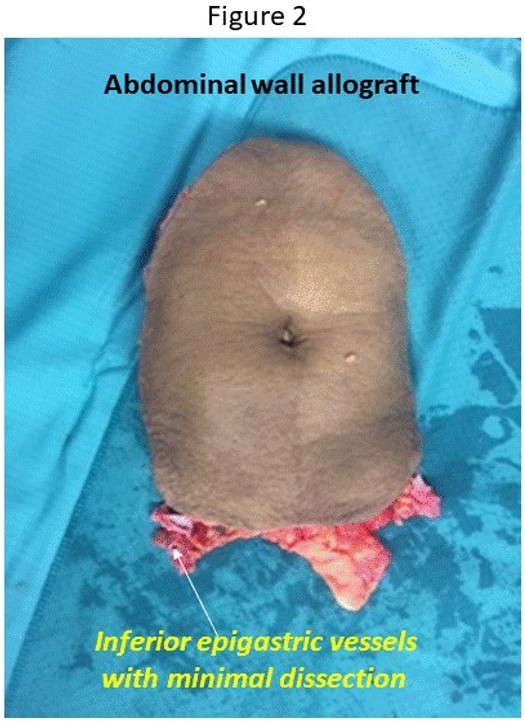Deceased Donor Vascularized Abdominal Wall Allograft Procurement – Lessons Learned from Early Experiences
J. A. Shah, D. L. Sudan, D. Erdmann, K. V. Ravindra
Abdominal Transplant Surgery, Duke University Medical Center, Durham, NC
Meeting: 2019 American Transplant Congress
Abstract number: A64
Keywords: Donors, unrelated, Intestinal transplantation, Multivisceral transplantation, Procurement
Session Information
Session Name: Poster Session A: Basic & Clinical Science – VCA
Session Type: Poster Session
Date: Saturday, June 1, 2019
Session Time: 5:30pm-7:30pm
 Presentation Time: 5:30pm-7:30pm
Presentation Time: 5:30pm-7:30pm
Location: Hall C & D
*Purpose: Vascularized abdominal wall allografts (AWA), which protect solid organs in patients with loss of abdominal domain or extensive abdominal wall damage, remain an essential adjunct to recipients of intestinal and multi-visceral allotransplantation. Ensuring adequate vascular flow to the allograft during solid abdominal organ procurement is critical. Our study aims at developing a standardized technique for AWA procurement.
*Methods: Four AWA procurements were performed (2 cadaveric, 2 deceased donors) over a 2-year period. Our study aims to: A) minimize cold ischemia time, B) provide meticulous dissection of the IE vessels while avoiding traction injury and C) provide appropriate vessels to be utilized as extension grafts during re-implantation. In brief, our technique involves incising the skin one inch lateral to the rectus muscle, detaching the flap from the costal margin, identifying the inferior epigastric (IE) vessel pedicles bilaterally and excising the pedicles with the femoral vessels.
*Results: Cold ischemia times are prolonged if the AWA is removed prior to the other solid organs. The IE vessels were injured during 2 procurements from traction injury as a result of excess dissection. Iliac vessels are not ideal extension grafts, as these are often sent with liver and pancreas grafts.
*Conclusions: Abdominal wall flaps should be raised at the start of procurement and placed on the thighs with inferior rectus attachments intact to avoid traction injury to the IE vessels (Fig 1). Connective tissue around the IE vessels should be preserved to minimize traction injury (Fig 2). The IE vessels should be dissected down to the femoral vessels immediately prior to aortic cross clamping to minimize cold ischemia time. A long segment of the femoral artery and vein should be preserved with the IE vessels to provide adequate length for re-implantation. The carotid artery and saphenous vein may be utilized when additional length is required. Adhering to these principles, improvement in successful AWA procurement may be achieved and efforts are currently underway to improve upon our technique.
To cite this abstract in AMA style:
Shah JA, Sudan DL, Erdmann D, Ravindra KV. Deceased Donor Vascularized Abdominal Wall Allograft Procurement – Lessons Learned from Early Experiences [abstract]. Am J Transplant. 2019; 19 (suppl 3). https://atcmeetingabstracts.com/abstract/deceased-donor-vascularized-abdominal-wall-allograft-procurement-lessons-learned-from-early-experiences/. Accessed December 27, 2025.« Back to 2019 American Transplant Congress


